How Australia became fertile ground for misinformation and QAnon | Australian politics
In his navy suit and blue tie, Malcolm George looked every bit the part as he launched his Liberal party-endorsed campaign for a seat in the Western Australian parliament back in 2016.
A now defunct candidate website lists his priorities for the Baldivis electorate on Perth’s suburban fringe as “a stronger local police presence”, “local job opportunities” and “increased recreational facilities for young families”.
Four years later, the anodyne political cliches are gone. Instead, George’s online life ranges from misinformation and conspiracy theory to posts about the Essendon football club.
On his Facebook page, videos of Sky News’ Rowan Dean railing against the so-called “great reset” sit alongside assertions that the US Democrats will institute “one world government”, while evangelical pastors claiming Donald Trump as the rightful US president are shared with invocations of the rhetoric of the QAnon conspiracy theory.
A devout evangelical Christian, George participated last year in an online “boot camp” run by the US-based Home Congregations Network, which is part of a broader movement of spiritual organisations that reinterpret QAnon through the lens of the Bible.
“Donald Trump will serve the next four years as President! Biden is guilty of treason and willl [sic] be arrested at some point along with Obama, Bill and Hilary [sic] Clinton and many other deep state operatives!” he wrote on 1 January.
Still an active member of the WA Liberal party, George is an example of the steady rise of what he called – borrowing from former Trump adviser Kellyanne Conway – “alternate facts”, and of Australia’s vulnerability to the same forces that have caused so much carnage in the US during the past few years.
In an interview with the Guardian last month, George confirmed he was now the Australian contact for the Home Congregations Network – a “minor” role that he declined to expand on. But he said although he is “interested” in QAnon, he is not a “follower”.
“I’m not someone who is waiting for the next Q drop [and] there is a lot more information out there which I think is more interesting than whatever they might say. Am I someone who has taken an interest in Q? Am I someone who has heard what they’ve got to say? Yes. But I’m not like a card-carrying member of the Q movement.”
George said he didn’t believe the Home Congregations Network was linked to QAnon – despite its website and sermons regularly sharing material linked to the conspiracy.
“I take an interest in a wide array of media sources including alternative media,” he said.
The rise of conspiracy in Australia
While the role of conspiracy theories, and particularly QAnon, in the lead up to the attack on the Capitol in Washington on 6 January helped to mark an inflection point in the US, Australia has been slower to recognise the threat those movements pose.
It’s difficult to measure the spread and influence of conspiracy movements among the broader Australian population, but polling from 2020 offers some insight into its influence during the Covid-19 pandemic. An Essential poll carried out in May last year found a significant number of people – 39% – believed Covid-19 was “engineered and released from a Chinese laboratory in Wuhan”.
A smaller – but consistent – rump of people polled also believed that Microsoft founder Bill Gates had “played a role in the creation and spread of Covid-19” (13%), the virus was “not dangerous and is being used to force people to get vaccines” (13%), and that 5G was being used to spread the virus (12%).
Underpinning much of the spread of conspiracy theories and misinformation in the US has been the dramatic rise of QAnon, a cult-like movement that claims without any evidence that during his presidency Donald Trump had secretly worked to thwart a cabal of elites made up of Democrats, Hollywood celebrities and billionaires who run the world while engaging in paedophilia, human trafficking and ritualistic child sacrifice.
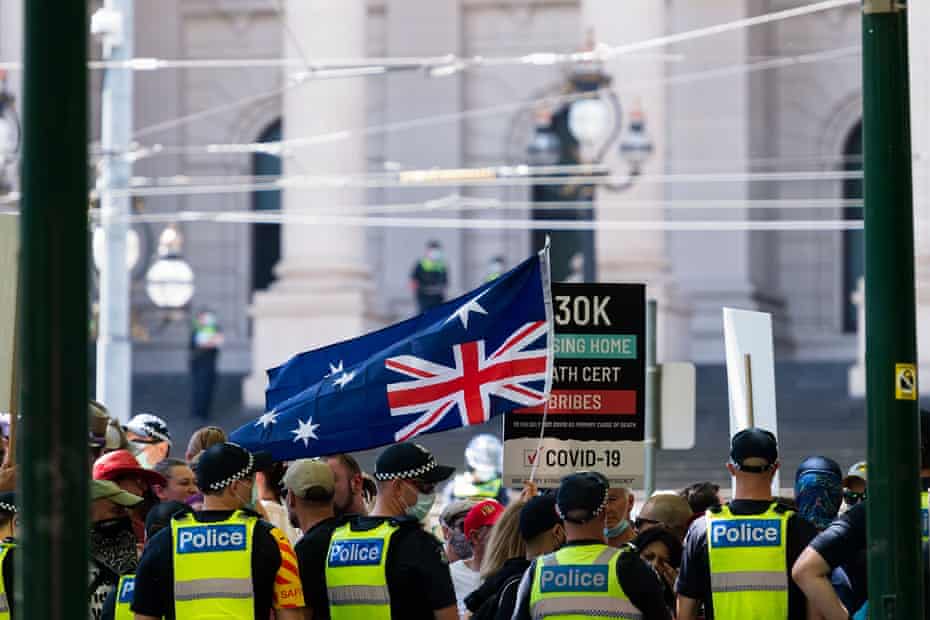
A December NPR/Ipsos poll found that 17% of American adults believed “a group of Satan-worshipping elites who run a child sex ring are trying to control our politics and media”. Another 37% said they didn’t know whether it was true or not.
Studies have shown that Australians are also among the theory’s largest proponents. Last year the Institute for Strategic Dialogue released a report that found QAnon’s following had grown considerably in Australia during 2020, with Facebook, Instagram, YouTube and Twitter driving increased engagement.
The report found Australia was the fourth largest country for QAnon activity, behind the US, UK and Canada. Its presence in Australia is also evident on less mainstream sites. For example as Canadian QAnon research Marc-Andre Argentino has pointed out, there were at least six Australian Q “research boards” on the site 8kun with about 4,000 posts by January last year. That had increased to 11 boards by the start of 2021.
6/ next up is the Australian Q research board with 6 boards and 4000 posts. Fair ammount of anti-Semitism, but also a lerge focus on pedophilia in Australia and in the Catholic Church. Also some interesting takes on the current bushfires pic.twitter.com/irPTzc2Pyo
— Marc-André Argentino (@_MAArgentino) January 19, 2020
Last year, Guardian Australia revealed QAnon had found a follower in Tim Stewart, a family friend of the prime Scott Morrison. Stewart was behind one of Australia’s largest QAnon-linked accounts, BurnedSpy34.
Stewart, whose wife worked as part of the prime minister’s staff, gained a significant following online thanks to his involvement in the conspiracy, and, as Crikey has previously reported, celebrated along with other Q followers when Morrison used the word “ritual” abuse in his formal apology to the survivors of institutional child abuse.
The response to the revelation from government was muted. Officials inside the Department of Premier and Cabinet told a Senate hearing they had not briefed the prime minister on the conspiracy theory despite the FBI’s decision to identify it as a potential domestic terror threat.
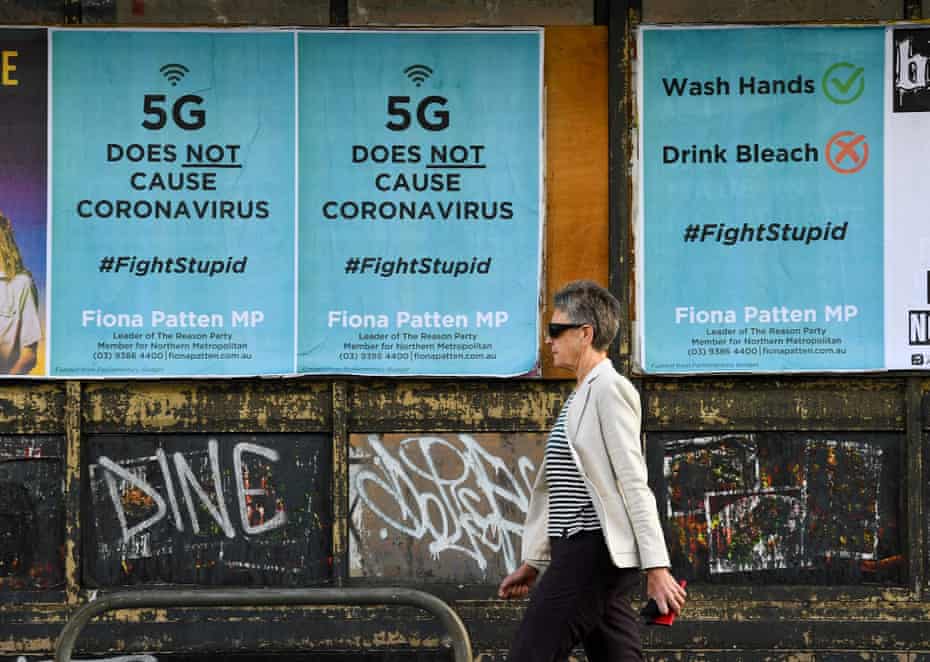
The department’s deputy secretary, Stephanie Foster, also told the hearing she was not aware Stewart’s account had been suspended by Twitter for “engaging in coordinated harmful activity”.
How misinformation travels
One of the most confounding aspects of QAnon’s global spread is its specificity to the US – the anonymous Q whose “drops” guide the cult’s bizarre theories purports to be a government insider with top security clearance, and the vast majority of its theories pertain to that country’s domestic politics.
Yet audiences in Australia have proven more than capable of adapting it to their context. During Melbourne’s 2020 Covid-19 outbreak for example, QAnon adherents pushed the baseless theory that the city’s lockdown was in fact a cover to allow children stolen from their families to be trafficked through secret tunnels under the city.
Similarly, a 2015 video of former Liberal party senator Bill Heffernan unsuccessfully attempting to submit a list of names of 28 prominent Australians he alleged were paedophiles during the royal commission into institutional responses to child sexual abuse is now a key plank of the cult’s canon here, offered as evidence of attempts to cover up widespread child abuse.
Part of that adaptability may be a function of how heavily the tenets of QAnon borrow from a long history of conspiratorial thinking. While QAnon may have begun in 2017 as a spin-off of the Pizzagate conspiracy, its themes are a continuation of conspiratorial movements that predate the internet, as well as the consolidation of several other theories originating in the live action role play game culture of internet message boards like 4chan.
The ISD report also points to a blurring of the lines between conspiracies, so that the bizarre theories at the centre of QAnon have blended with the anti-vaccine movement, 5G conspiracies and other “antisemitic and anti-migrant tropes”.
That trend was especially evident in Australia during Melbourne’s long 2020 Covid-19 lockdown, when a string of protests organised by a loose collection of conspiracy groups led to dozens of arrests last year. At various gatherings, eclectic crowds of people waved signs aligned to a broad mix of causes including QAnon and 5G, as well as calling for the arrest of Microsoft founder Bill Gates because of his involvement in the production of a coronavirus vaccine.
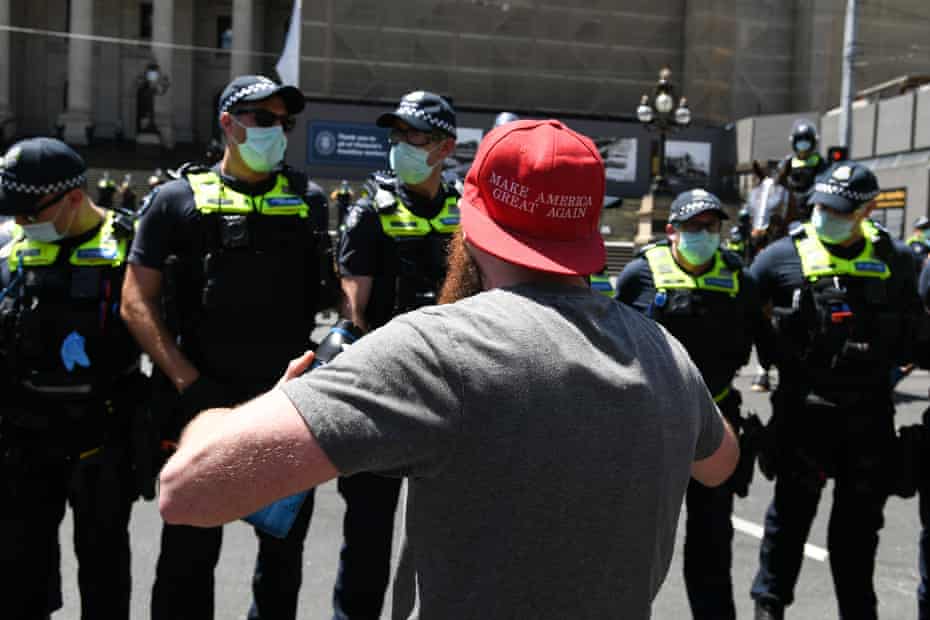
Peter Trute, the former editor of the Australian Associated Press FactCheck who worked on addressing misinformation for the wire service until August last year, said that during Covid-19 a broad overlap between anti-5G and anti-vaccination actors saw the messages of both crowds intertwine.
“The 5G stuff was already around by last year but it latched on to Covid very early in the year and it allowed the anti-vaccine crowd an opportunity to adapt the message,” he says.
“We were seeing a lot of bad actors spreading content which basically said, you know, Covid was a plot to keep people in their homes while 5G was erected and that a Covid vaccine would contain a chip that would somehow be controlled by the 5G network, which would be part of the one-world UN agenda.”
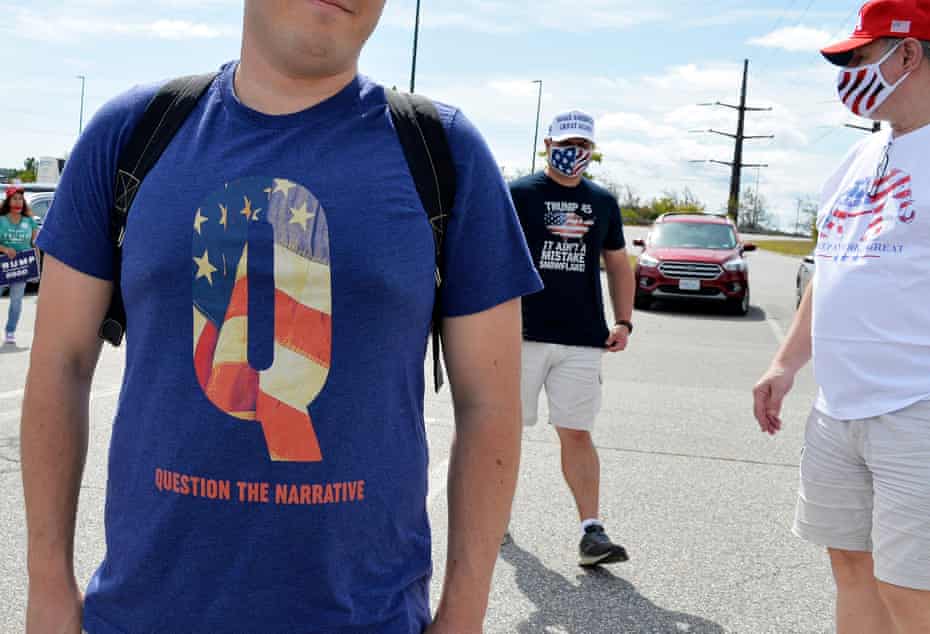
Trute said the vast bulk of Australian conspiracy material was imported directly from the US, UK and Europe. A persistent and baseless claim that last summer’s bushfires had been orchestrated to clear land for a high speed rail line as part of Agenda 21, had been imported directly from California where it had surfaced two years earlier.
Last year a government MP installed security cameras at her home because she feared being physically attacked in her home after a conspiracy theorist accused her, baselessly, of being “a member of a secretive paedophile network”. That threat came from a misguided theory that alleged Australia was controlled by a group of Freemasons.
The theory’s central tenets aligned with QAnon without specifically referring to its lore.
Joshua Roose, a senior research fellow at Deakin University says, one of the reasons QAnon has proven to be so “magnetic” is how universal its themes are.
“Q in the Australian context is really amorphous, so when you talk about Q you’re more talking about an affiliation. You’re talking about someone identifying with something that is anti-establishment, a lack of trust in institutions and politicians, and with something that claims to be seeking the truth and fighting for good in the world,” he says.
“Conspiracy theories have been around for hundreds of years, and really you’ve got to look at the conditions that give birth to them. We’re in a period of extreme lack of trust in politicians, of economic downturn, and of polarisation. It’s in that context that people can come along and make these grandiose claims and find traction because people are looking for something to believe and for something to belong to.”
That elasticity may prove to be a telling indicator for QAnon’s future. Though much has been made of a crisis among its followers after Joe Biden’s inauguration, Roose warns that the conditions underpinning it have not been addressed.

“The big point here is this has all happened in the decade post the global financial crisis, and I think we’ve seen the impacts of that weren’t always immediate. Five or six years after the GFC, globally you’ve seen the rise of far-right populist movements in not just the US with Trump but Brexit, Australia, Poland, Hungary, Italy, India, the Philippines and Brazil,” he says.
“We’ve just undergone the biggest economic hit in close to a century. These issues are not going to go away, they’re only going to get bigger. We’re at a really critical juncture in our democracy and if governments don’t reach out and engage people and put more effort into social cohesion we will see lots more polarisation to come.”
Inside government ranks
The presence of two government MPs in the ranks of those willing to openly and persistently propagate conspiracy theories, and their attendant popularity on social media, is probably the most blatant evidence that Australia is not immune to the great unravelling that has permeated the US.
The prime minister, Scott Morrison, for months repeatedly refused to publicly rebuke the Hughes MP Craig Kelly for the constant stream of misinformation about Covid-19 treatments that he has spent the past year peddling. Nor did he or his senior cabinet colleagues offer any public criticism of fellow Coalition MP George Christensen after he parroted Donald Trump’s baseless claims about election fraud in the US.
But Kelly and Christensen are not alone –indeed, there is no shortage of examples to demonstrate the enthusiastic adoption of those same forces by mainstream political figures in Australia. Four years after Malcolm George lost his election bid, the WA Liberal party preselected the pastor and lawyer Andrea Tokaji to run in the same seat of Baldivis.
In January, Tokaji was forced to quit as the party’s candidate after it was revealed she wrote an article on the conservative website Cauldron Pool that suggested the Covid-19 virus had been caused by 5G technology, and claimed that during pandemic lockdowns “5G towers are being rolled out, against our knowledge”.
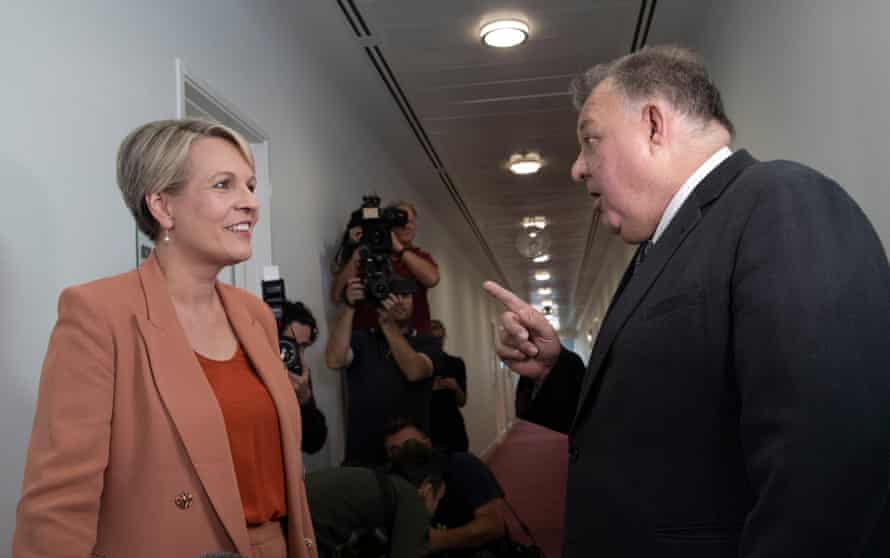
And the creep of conspiratorial thinking during the pandemic has not apparently been restricted to the political right. What people on both ends of the left-right spectrum have in common is “a distrust in ‘the system’ and a desire to replace it with something that better reflects their values,” Roose says.
In December, in the northern New South Wales town of Mullumbimby – famous for its alternative lifestyle – a leftwing group called Turning Point Talks hosted a speaker who uses the name Max Igan at the town’s Politics in the Pub.
Igan – whose website states that this is a nom de plume – is a longtime conspiracist banned from YouTube who claims, variously, that Joe Biden is a paedophile, Hillary Clinton engages in child trafficking, and that Covid-19 is a “fraud” orchestrated to institute one world government and install “new operating systems” into people through the rollout of vaccines.
Beyond QAnon
People like Igan and George may be an example of the persistence of the ideas underpinning QAnon, if not the theory itself. Igan is not a QAnon adherent – in fact he has described it as a “psyop”. Yet the language and preoccupations of both men closely mirror those of QAnon, and point to the possibility that the ideas central to it could persist far beyond its shelf life as the conspiracy du jour.
Roose says Australia needs to be alert to the extent that misinformation and conspiracy theories are spreading out of sight.
“The danger is that these things become normative and people start integrating them uncritically into normal conversations. If you think back 10 years ago, some of the things that are in mainstream discourse now are just mind-blowing – and that’s the real danger, because it subverts not so much truth but fact and evidence-based policymaking.
“These issues are not going to go away, they’re only going to get bigger. We’re at a really critical juncture in our democracy and if governments don’t reach out and engage people and put more effort into social cohesion and developing trust in institutions, we will see lots more to come.”
From anti-vaxxers to 5G conspiracists, the Web of lies series explores the growth and spread of misinformation and conspiracy thinking in Australia.

